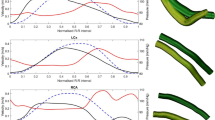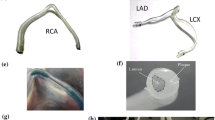Abstract
The purpose of this work was to investigate the effects of physiologically realistic cardiac-induced motion on hemodynamics in human right coronary arteries. The blood flow patterns were numerically simulated in a modeled right coronary artery (RCA) having a uniform circular cross section of 2.48 mm diam. Arterial motion was specified based on biplane cineangiograms, and incorporated physiologically realistic bending and torsion. Simulations were carried out with steady and pulsatile inflow conditions (mean ReD=233, α =1.82) in both fixed and moving RCA models, to evaluate the relative importance of RCA motion, flow pulsation, and the interaction between motion and flow pulsation. RCA motion with a steady inlet flow rate caused variations in wall shear stress (WSS) magnitude up to 150% of the inlet Poiseuille value. There was significant spatial variability in the magnitude of this motion-induced WSS variation. However, the time-averaged WSS distribution was similar to that predicted in a static model representing the time-averaged geometry. Furthermore, the effects of flow pulsatility dominated RCA motion-induced effects; specifically, there were only modest differences in the WSS history between simulations conducted in fixed and moving RCA models with pulsatile inflow. RCA motion has little effect on time-averaged WSS patterns. It has a larger effect on the temporal variation of WSS, but even this effect is overshadowed by the variations in WSS due to flow pulsation. The hemodynamic effects of RCA motion can, therefore, be ignored as a first approximation in modeling studies. © 2003 Biomedical Engineering Society.
PAC2003: 8719Uv, 8719Hh, 8719St, 8719Rr
Similar content being viewed by others
REFERENCES
Asakura, T., and T. Karino. Flow patterns and spatial distribution of atherosclerotic lesions in human coronary arteries. Circ. Res.66:1045–1066, 1990.
Ding, Z. A system for quantification of the motion dynamics of human coronary arteries and its application in the biomechanical study of clinical coronary cineangiograms. PhD thesis, The Ohio State University, 1999.
Ding, Z., and M. H. Friedman. Dynamics of human coronary arterial motion and its potential role in coronary atherogenesis. J. Biomech. Eng.122:488–492, 2000.
Ding, Z., and M. H. Friedman. Quantification of 3D coronary arterial motion using clinical biplane cineangiograms. Int. J. Card. Imaging16:331–346, 2000.
Ethier, C. R., D. A. Steinman, and M. Ojha. Comparisons between Computational Hemodynamics, Photochromic Dye Flow Visualization and MR Velocimetry, edited by X. Y. Xu and M. W. Collins. Ashurst, U.K: Computational Mechanics, 1999; p. 131.
Gibson, C. M., L. Diaz, K. Kandarpa, F. M. Sacks, R. C. Pasternak, T. Sandor, C. Feldman, and P. H. Stone. Relation of vessel wall shear stress to atherosclerosis progression in human coronary arteries. Arterioscler. Thromb.13:310–315, 1993.
He, X., and D. N. Ku. Pulsatile flow in the human left coronary artery bifurcation: average conditions. J. Biomech. Eng.118:74–82, 1996.
Huerta, A., and W. K. Liu. Viscous-flow with large free-surface motion. Comput. Methods Appl. Mech. Eng.69:277–324, 1988.
Krams, R., J. J. Wentzel, J. A. Oomen, J. C. Schuurbiers, I. Andhyiswara, J. Kloet, M. Post, B. de Smet, C. Borst, C. J. Slager, and P. W. Serruys. Shear stress in atherosclerosis, and vascular remodeling. Semin. Interv. Cardiol.3:39–44, 1998.
Krams, R., J. J. Wentzel, J. A. Oomen, R. Vinke, J. C. Schuurbiers, P. J. de Feyter, P. W. Serruys, and C. J. Slager. Evaluation of endothelial shear stress and 3D geometry as factors determining the development of atherosclerosis and remodeling in human coronary arteries: Combining 3D reconstruction from angiography and IVUS (ANGUS) with computational fluid dynamics. Arterioscler., Thromb., Vasc. Biol.17:2061–2065, 1997.
Ku, D. N., D. P. Giddens, C. K. Zarins, and S. Glagov. Pulsatile flow and atherosclerosis in the human carotid bifurcation. Positive correlation between plaque location and low oscillating shear stress. Arteriosclerosis (Dallas)5:293–302, 1985.
Maday, Y., A. T. Patera, and E. M. Ronquist. An operator-integration-factor splitting method for time-dependent problems: Application to incompressible fluid flow. J. Sci. Comput.5:263–292, 1990.
Matsuo, S., M. Tsuruta, M. Hayano, Y. Imamura, Y. Eguchi, T. Tokushima, and S. Tsuji. Phasic coronary artery flow velocity determined by Doppler flowmeter catheter in aortic stenosis and aortic regurgitation. Am. J. Cardiol.62:917–922, 1988.
Myers, J. G., J. A. Moore, M. Ojha, K. W. Johnston, and C. R. Ethier. Factors influencing blood flow patterns in the human right coronary artery. Ann. Biomed. Eng.29:109–120, 2001.
Ojha, M., R. L. Leask, J. Butany, and K. W. Johnston. Distribution of intimal and medial thickening in the human right coronary artery: A study of 17 RCAs. Arterioscler., Thromb., Vasc. Biol.158:147–153, 2001.
Perktold, K., M. Prosi, A. Leuprecht, Z. Ding, and M. H. Friedman. Curvature effects on bifurcating coronary artery flow. Proc. 2001 Summer Bioengineering Conference, Snowbird, UT, edited by R. D. Kamm, G. W. Schmid-Schonbein, G. A. Ateshion, and M. S. Hefzy. New York: ASME-BED, 2001, p. 69.
Prakash, S., and C. R. Ethier. Enhanced error estimator for adaptive finite element analysis of 3D incompressible flow. Comput. Methods Appl. Mech. Eng.190:5413–5426, 2001.
Qiu, Y., and J. M. Tarbell. Numerical simulation of pulsatile flow in a compliant curved tube model of a coronary artery. J. Biomech. Eng.122:77–85, 2000.
Santamarina, A., E. Weydahl, J. M. Siegel, Jr., and J. E. Moore, Jr.Computational analysis of flow in a curved tube model of the coronary arteries: Effects of time-varying curvature. Ann. Biomed. Eng.26:944–954, 1998.
Van Langenhove, G., J. J. Wentzel, R. Krams, C. J. Slager, J. N. Hamburger, and P. W. Serruys. Helical velocity patterns in a human coronary artery: A three-dimensional computational fluid dynamic reconstruction showing the relation with local wall thickness. Circulation102:E22–E24, 2000.
Vosse, F. N., F. J. H. Gijsen, and B. J. B. M. Wolters. Numerical analysis of coronary artery flow. In: 2001 Advances in Bioengineering, ASME-BED, edited by R. D. Kamm et al. New York: American Society of Mechanical Engineers, 2001, p. 17.
Wang, C.-Y.The squeezing of a fluid between two plates. J. Appl. Mech.43:579–583, 1976.
Weydahl, E. S., and J. E. Moore. Dynamic curvature strongly affects wall shear rates in a coronary artery bifurcation model. J. Biomech.34:1189–1196, 2001.
Zeng, D. Finite element simulation of blood flow in moving human coronary arteries. PhD thesis, Department of Me-chanical and Industrial Engineering, University of Toronto, 2003.
Zeng, D., Z. Ding, M. H. Friedman, and C. R. Ethier. Finite element simulation of blood flow in a realistic model of a moving human right coronary artery. Proceedings of the 10th Annual Conference of the CFD Society of Canada, edited by R. M. Barron. Windsor, Ontario, Canada: CFD Society of Canada, 2002, p. 317.
Zeng, D., and C. R. Ethier. A semitorsional spring analogy model for updating unstructured meshes. Proceedings of the 9th Annual Conference of the CFD Society of Canada, edited by G. E. Schneider. Waterloo, Ontario, Canada: CFD Society of Canada, 2001, p. 113.
Zeng, D., and C. R. Ethier. A mesh updating scheme for hemodynamic simulations in vessels undergoing large deformations. J. Eng. Math. (submitted).
Author information
Authors and Affiliations
Rights and permissions
About this article
Cite this article
Zeng, D., Ding, Z., Friedman, M.H. et al. Effects of Cardiac Motion on Right Coronary Artery Hemodynamics. Annals of Biomedical Engineering 31, 420–429 (2003). https://doi.org/10.1114/1.1560631
Issue Date:
DOI: https://doi.org/10.1114/1.1560631




